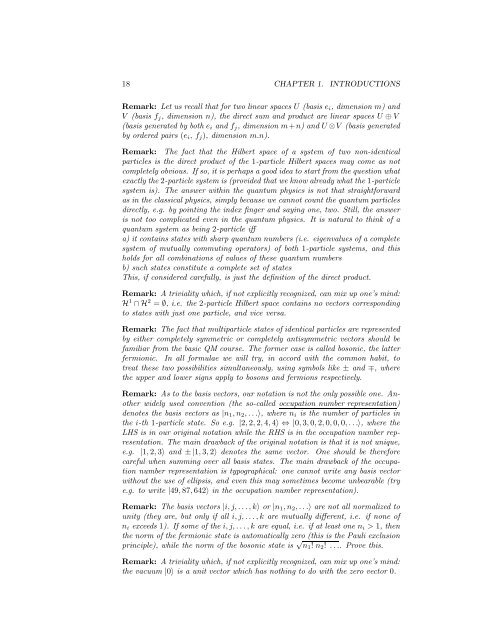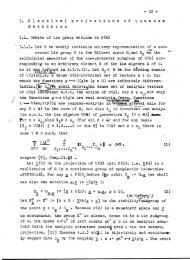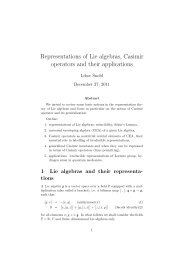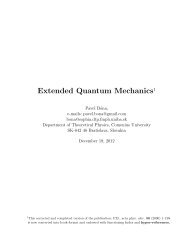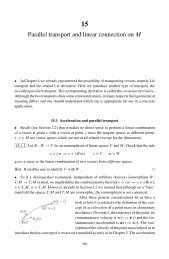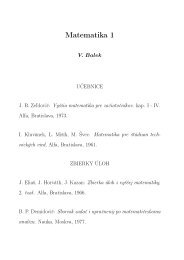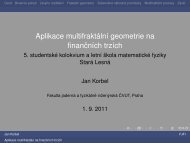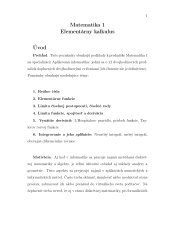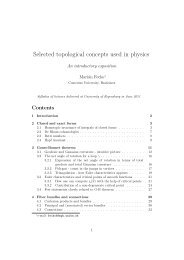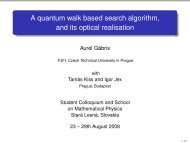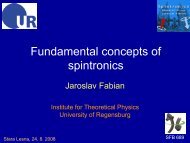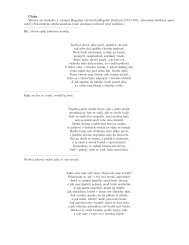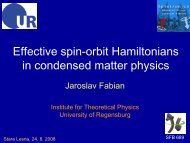Quantum Field Theory I
Quantum Field Theory I
Quantum Field Theory I
Create successful ePaper yourself
Turn your PDF publications into a flip-book with our unique Google optimized e-Paper software.
18 CHAPTER 1. INTRODUCTIONS<br />
Remark: Let us recall that for two linear spaces U (basis e i , dimension m) and<br />
V (basis f j , dimension n), the direct sum and product are linear spaces U ⊕V<br />
(basis generated by both e i and f j , dimension m+n) and U⊗V (basis generated<br />
by ordered pairs (e i , f j ), dimension m.n).<br />
Remark: The fact that the Hilbert space of a system of two non-identical<br />
particles is the direct product of the 1-particle Hilbert spaces may come as not<br />
completely obvious. If so, it is perhaps agood idea to start from the question what<br />
exactly the 2-particle system is (provided that we know already what the 1-particle<br />
system is). The answer within the quantum physics is not that straightforward<br />
as in the classical physics, simply because we cannot count the quantum particles<br />
directly, e.g. by pointing the index finger and saying one, two. Still, the answer<br />
is not too complicated even in the quantum physics. It is natural to think of a<br />
quantum system as being 2-particle iff<br />
a) it contains states with sharp quantum numbers (i.e. eigenvalues of a complete<br />
system of mutually commuting operators) of both 1-particle systems, and this<br />
holds for all combinations of values of these quantum numbers<br />
b) such states constitute a complete set of states<br />
This, if considered carefully, is just the definition of the direct product.<br />
Remark: A triviality which, if not explicitly recognized, can mix up one’s mind:<br />
H 1 ∩H 2 = ∅, i.e. the 2-particle Hilbert space contains no vectors corresponding<br />
to states with just one particle, and vice versa.<br />
Remark: The fact that multiparticle states of identical particles are represented<br />
by either completely symmetric or completely antisymmetric vectors should be<br />
familiar from the basic QM course. The former case is called bosonic, the latter<br />
fermionic. In all formulae we will try, in accord with the common habit, to<br />
treat these two possibilities simultaneously, using symbols like ± and ∓, where<br />
the upper and lower signs apply to bosons and fermions respectively.<br />
Remark: As to the basis vectors, our notation is not the only possible one. Another<br />
widely used convention (the so-called occupation number representation)<br />
denotes the basis vectors as |n 1 ,n 2 ,...〉, where n i is the number of particles in<br />
the i-th 1-particle state. So e.g. |2,2,2,4,4〉 ⇔ |0,3,0,2,0,0,0,...〉, where the<br />
LHS is in our original notation while the RHS is in the occupation number representation.<br />
The main drawback of the original notation is that it is not unique,<br />
e.g. |1,2,3〉 and ±|1,3,2〉 denotes the same vector. One should be therefore<br />
careful when summing over all basis states. The main drawback of the occupation<br />
number representation is typographical: one cannot write any basis vector<br />
without the use of ellipsis, and even this may sometimes become unbearable (try<br />
e.g. to write |49,87,642〉 in the occupation number representation).<br />
Remark: The basis vectors |i,j,...,k〉 or |n 1 ,n 2 ,...〉 are not all normalized to<br />
unity (they are, but only if all i,j,...,k are mutually different, i.e. if none of<br />
n i exceeds 1). If some of the i,j,...,k are equal, i.e. if at least one n i > 1, then<br />
the norm of the fermionic state is automatically zero (this is the Pauli exclusion<br />
principle), while the norm of the bosonic state is √ n 1 ! n 2 ! .... Prove this.<br />
Remark: A triviality which, if not explicitly recognized, can mix up one’s mind:<br />
the vacuum |0〉 is a unit vector which has nothing to do with the zero vector 0.


